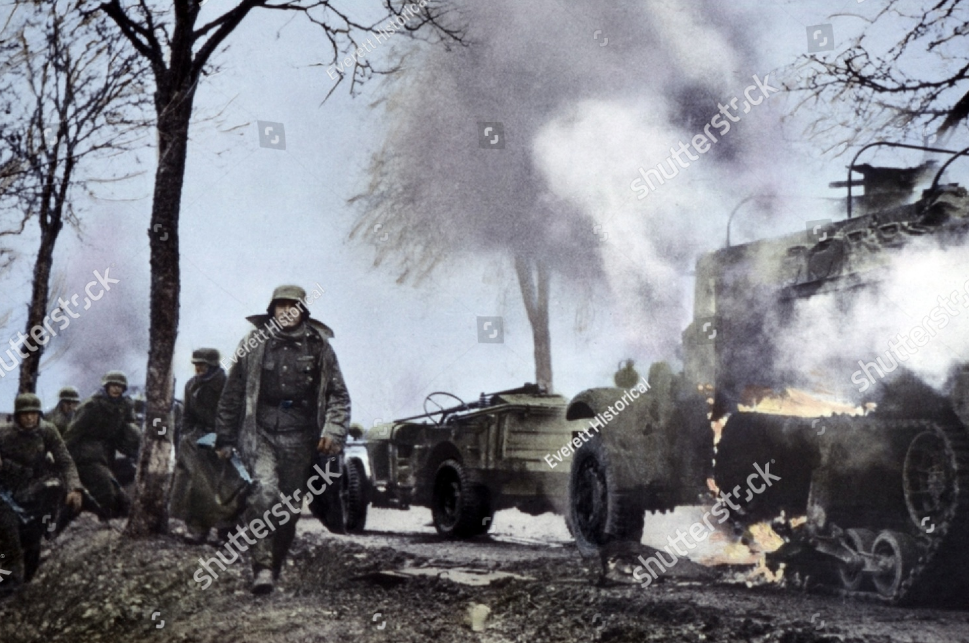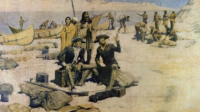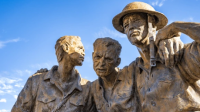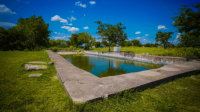Introduction: The Last Gamble of Nazi Germany
The Battle of the Bulge, which occurred from December 16, 1944, to January 25, 1945, was Adolf Hitler’s final major offensive against the Allied forces during World War II. Taking place in the densely forested Ardennes region, the Germans sought to divide the Allies and capture the critical port of Antwerp. Despite achieving initial success, the offensive ultimately failed, hastening the downfall of the Nazi regime. This battle became one of the deadliest for both sides, with enduring significance in WWII history.
Read Also : The Marbury v. Madison Case (1803): Establishing Judicial Review in American Law
The Strategic Build-Up to the Battle
The Battle of the Bulge did not occur in isolation; it was the result of strategic calculations by both Nazi Germany and the Allies. By late 1944, the war in Europe appeared to be winding down, but Hitler still believed he could reverse Germany’s fortunes with one decisive blow.
Germany’s Plan to Break the Western Front
The Ardennes Offensive was conceived as a bold, last-ditch effort to halt the Allies’ momentum. Hitler aimed to push through the lightly defended Ardennes forest, capture the vital Belgian port of Antwerp, and split the Allied forces. His hope was to force a negotiated peace, especially with the Western Allies, allowing him to focus on the Eastern Front against the Soviet Union.
The offensive was planned with a combination of stealth and speed. Hitler believed that the heavily wooded terrain would conceal German movements from the Allies, while the harsh winter weather would ground Allied air support, which had been a key factor in previous victories. The offensive would rely on armored Panzer divisions supported by infantry and artillery.
However, the plan was fraught with risks. Germany’s supply lines were overstretched, and the success of the operation relied heavily on capturing Allied fuel depots along the way. The offensive also required the Germans to move quickly through the rugged terrain, which would become increasingly difficult as the Allies regrouped and launched counterattacks.
The Allies’ Overconfidence and Miscalculations
By late 1944, the Allies were confident of an impending victory over Germany. After the successful D-Day landings and the liberation of France, many believed that the German army was close to collapse. The Ardennes sector, held by American forces, was seen as a quiet zone where weary troops could rest and regroup. As a result, it was lightly defended, with many units comprising inexperienced or under-strength soldiers.
The Allied high command did not anticipate a large-scale German offensive through the Ardennes due to the rough terrain and poor weather conditions. Intelligence reports indicating a buildup of German forces in the region were either dismissed or ignored. This overconfidence left the Allies vulnerable to the surprise attack that was soon to come.
When the German offensive began, the Allied forces were caught off guard, and the thinly defended Ardennes line quickly buckled under the weight of the assault. The initial success of the Germans created a deep bulge in the Allied front, which gave the battle its name.
The Importance of the Ardennes Region in Military Strategy
The Ardennes region, with its dense forests, narrow roads, and rugged hills, played a significant role in shaping the strategies of both the Germans and the Allies. The terrain was challenging for large-scale military operations, but it also provided opportunities for concealment and surprise attacks. For the Germans, the Ardennes offered a chance to launch a stealthy offensive that could catch the Allies off guard.
For the Allies, the region was considered secondary in importance compared to other fronts, leading to the decision to station less experienced troops there. This miscalculation allowed the Germans to exploit the area’s vulnerabilities during the initial phase of the offensive. However, as the battle wore on, the difficult terrain also hindered the Germans’ advance, slowing their progress and giving the Allies time to regroup.
The Ardennes’ role in the battle underscored the importance of understanding and utilizing terrain in military strategy. The region’s forests and hills became a battleground where control of key roads and towns would determine the outcome of the offensive.
Intelligence Failures Leading to the Battle
The lack of adequate intelligence gathering and the failure to act on existing intelligence reports significantly contributed to the Allies’ vulnerability during the early stages of the Battle of the Bulge. Several reports from resistance groups and reconnaissance missions indicated that the Germans were planning a large-scale operation in the Ardennes. However, these warnings were largely ignored by the Allied command, who did not believe that the Germans had the strength to mount a major offensive.
The Allies believed that the German army was too weakened to launch a significant attack, and that any German forces in the Ardennes were there merely to defend against an Allied push into Germany. This miscalculation allowed the Germans to amass their forces in secret and strike with near-complete surprise.
In hindsight, the intelligence failures highlight the importance of vigilance and preparedness, even when the enemy appears to be on the brink of collapse. The Allies’ overconfidence and underestimation of the Germans’ capabilities nearly cost them a significant defeat.
The Role of Weather in Shaping the Battle
The harsh winter weather played a crucial role in the Battle of the Bulge, influencing both the German offensive and the Allied response. Heavy snow and freezing temperatures made conditions difficult for both sides, but the Germans initially benefited from the poor weather, which grounded the Allies’ air forces and allowed the Germans to move undetected through the Ardennes.
The fog and snowstorms also slowed the Allies’ ability to reinforce their lines and launch counterattacks. The difficult terrain, combined with the extreme cold, made it challenging for soldiers to move and fight effectively. Many soldiers on both sides suffered from frostbite and exposure, and the weather made resupplying the front lines a logistical nightmare.
As the battle progressed and the weather began to improve, the Allies were able to bring their superior air power to bear, bombing German positions and supply lines, and helping to turn the tide of the battle in their favor.
The German Offensive: A Desperate Push
On December 16, 1944, the Germans launched their offensive with a surprise attack across an 80-mile front in the Ardennes. The assault began with a massive artillery barrage, followed by waves of infantry and tanks pushing through the fog and snow, overwhelming the American forces.
The Initial Success of the German Attack
The Germans achieved significant success in the early days of the offensive. Their surprise attack caught the American forces off guard, allowing the Germans to break through the thinly held Allied lines. The initial phase of the attack saw rapid gains, with the Germans advancing up to 50 miles into Allied-held territory and capturing thousands of American soldiers.
The element of surprise was crucial to the German success. Heavy fog and snow grounded the Allies’ superior air forces, preventing them from launching counterattacks against the advancing German tanks and infantry. The Germans quickly took advantage of the chaos, capturing key towns and bridges, further disrupting the Allies’ ability to mount a coordinated defense.
Despite the early gains, the German advance began to slow as logistical problems emerged. The narrow roads of the Ardennes became choked with traffic, and the Germans struggled to resupply their forward units. The capture of Allied fuel depots, a critical component of the German plan, did not occur as quickly as needed, further hampering their progress.
The Creation of the Bulge in the Allied Front Line
As the Germans advanced, they created a large “bulge” in the Allied front line, which stretched across Belgium and Luxembourg. This bulge extended nearly 50 miles into Allied territory, threatening to split the American and British forces and disrupt their supply lines. The German offensive reached its high-water mark near the town of Dinant, but the deeper the Germans pushed into Allied territory, the more difficult it became for them to sustain their momentum.
The bulge created logistical challenges for both sides. For the Germans, the longer supply lines and difficult terrain made it harder to maintain their advance. For the Allies, the bulge disrupted communications and supply routes, forcing them to scramble to reposition their forces and contain the German breakthrough.
The German success in creating the bulge initially sowed panic among the Allied high command. However, as the days wore on, the Germans found themselves stretched too thin, unable to capitalize on their early gains. The bulge that had once threatened the Allied position soon became a trap for the German forces, as the Allies regrouped and began to launch counterattacks.
The Role of the Panzer Divisions in the Offensive
The German offensive was spearheaded by several elite Panzer divisions, which were tasked with punching through the Allied lines and driving toward Antwerp. These armored units, equipped with the fearsome Tiger and Panther tanks, were the backbone of the German attack. The Panzers were expected to move quickly through the Ardennes, seize key objectives, and maintain the momentum of the offensive.
In the early days of the battle, the Panzer divisions achieved significant success, cutting through the American defenses and creating chaos in the Allied rear areas. However, the difficult terrain of the Ardennes, combined with the harsh winter weather, slowed their advance. The narrow roads and dense forests made it difficult for the tanks to maneuver, and the lack of fuel further hindered their progress.
As the battle wore on, the Panzer divisions found themselves bogged down in the snow and mud of the Ardennes. The inability to capture Allied fuel depots left many German tanks stranded, unable to move or fight effectively. The failure of the Panzer divisions to achieve their objectives marked the beginning of the end for the German offensive.
The Siege of Bastogne: A Defining Moment in the Battle
One of the most significant engagements of the Battle of the Bulge was the siege of Bastogne, a small town in Belgium that held a key crossroads. The Germans knew that capturing Bastogne was crucial to their plan, as control of the town would allow them to advance further into Belgium and cut off Allied supply lines. The defense of Bastogne by American forces, particularly the 101st Airborne Division, became a symbol of American resilience and heroism during the battle.
The Germans encircled Bastogne on December 19, 1944, cutting off the town from outside reinforcements and supplies. The American forces inside the town, numbering around 18,000 men, were outnumbered and outgunned, facing fierce artillery bombardments and repeated German attacks. Despite these challenges, the defenders of Bastogne, under the command of Brigadier General Anthony McAuliffe, held their ground.
The siege lasted for several days, with the Americans enduring freezing temperatures, limited food and ammunition, and continuous German assaults. When the German commander demanded the surrender of the town, General McAuliffe famously responded with a one-word reply: “Nuts!” This defiant stand by the American forces became a rallying cry for the Allies and a symbol of their determination to win the battle.
The Role of General Patton and the Third Army
General George S. Patton played a critical role in the Battle of the Bulge, particularly in the relief of Bastogne. Patton’s Third Army was stationed in the Saar region when the German offensive began, but he quickly recognized the importance of Bastogne and made the bold decision to turn his forces north to relieve the besieged town. This maneuver was a remarkable feat of military logistics and strategy, as Patton’s troops had to cover over 100 miles in freezing weather and treacherous terrain.
Patton’s ability to rapidly reposition his forces and launch a counterattack was a turning point in the battle. On December 26, 1944, elements of the Third Army broke through the German lines and relieved the defenders of Bastogne. This action not only saved the town but also helped to stabilize the Allied front and begin the process of pushing the Germans back.
Patton’s leadership during the Battle of the Bulge cemented his reputation as one of the most capable and aggressive commanders of the war. His decision to prioritize the relief of Bastogne, despite the risks involved, demonstrated his strategic insight and commitment to supporting his fellow soldiers.
The Importance of Air Power in Reversing the German Advance
As the weather improved in late December 1944, Allied air power played a crucial role in reversing the German advance. The fog and snowstorms that had initially grounded Allied planes began to clear, allowing the Allies to launch devastating air strikes against German positions, supply lines, and reinforcements. The reappearance of Allied bombers and fighters significantly weakened the German offensive and disrupted their ability to continue pushing forward.
Air superiority was one of the key advantages that the Allies held over the Germans, and once the weather cleared, it became a decisive factor in the outcome of the battle. Allied planes targeted German tanks, supply convoys, and troop concentrations, making it difficult for the Germans to sustain their momentum. In addition to ground attacks, the Allies were able to resupply the besieged forces in Bastogne by air, dropping much-needed food, ammunition, and medical supplies to the defenders.
The ability of the Allies to bring their air power to bear once the weather cleared marked the beginning of the end for the German offensive. The combination of air strikes and ground counterattacks gradually wore down the German forces, forcing them to retreat.
The Collapse of the German Offensive
By early January 1945, the German offensive had stalled, and the Allies had begun to regain the initiative. The failure to capture key objectives, such as Bastogne, combined with the logistical difficulties of maintaining an offensive in harsh winter conditions, led to the collapse of the German advance. German forces, exhausted and running low on supplies, began to withdraw from their positions in the Ardennes.
The German high command had gambled everything on the success of the Ardennes Offensive, but as the battle dragged on, it became clear that the operation was doomed. German casualties were mounting, and their forces were increasingly isolated and vulnerable to Allied counterattacks. The failure of the offensive marked the beginning of the end for Nazi Germany, as the Allies pressed forward into the heart of Germany.
The collapse of the German offensive was a turning point in the war. It signaled that Germany no longer had the ability to launch large-scale operations and that the tide of the war had irreversibly turned in favor of the Allies. The defeat at the Battle of the Bulge hastened the collapse of the German war effort and set the stage for the final Allied push into Germany.
The Aftermath of the Battle: Consequences and Impact
The Battle of the Bulge was one of the largest and bloodiest battles fought by the United States during World War II. It had significant consequences for both the Germans and the Allies, shaping the final months of the war in Europe.
The Toll on American Forces
The Battle of the Bulge was the costliest battle for the United States in World War II, with over 19,000 American soldiers killed, 47,500 wounded, and 23,000 missing or captured. The sheer scale of the battle, combined with the harsh winter conditions and the intensity of the fighting, took a heavy toll on the American forces. Many units suffered heavy casualties, and the psychological impact of the battle on the soldiers who fought there was profound.
Despite the losses, the Battle of the Bulge demonstrated the resilience and determination of the American military. The ability of American forces to regroup, counterattack, and ultimately defeat the German offensive was a testament to their training, leadership, and commitment to the war effort.
The Impact on German Forces and Morale
For Nazi Germany, the Battle of the Bulge was a devastating defeat. The offensive had been Hitler’s last major attempt to change the course of the war, and its failure had far-reaching consequences. Germany had committed a significant portion of its remaining reserves to the Ardennes Offensive, and the loss of men, tanks, and equipment crippled the German war effort.
The failure of the offensive also had a profound impact on German morale. Many German soldiers had been led to believe that the Ardennes Offensive would turn the tide of the war, but the collapse of the operation shattered those hopes. The defeat at the Battle of the Bulge marked the beginning of the final collapse of the Nazi regime, as the Allies advanced into Germany from both the east and west.
The Legacy of the Battle of the Bulge
The Battle of the Bulge remains one of the most significant battles of World War II, remembered for both the heroism of the soldiers who fought there and the strategic importance of the outcome. It is often cited as a testament to the resilience of the Allied forces and their ability to overcome adversity, even in the face of overwhelming odds.
The battle also highlighted the importance of leadership, with figures like General Patton and General McAuliffe playing crucial roles in the Allied victory. The siege of Bastogne, in particular, became a symbol of American determination and courage, immortalized in history and popular culture.
The legacy of the Battle of the Bulge continues to be honored through memorials, ceremonies, and the preservation of the battlefields where the fighting took place. The lessons learned from the battle, both in terms of military strategy and the human cost of war, continue to resonate with military historians and veterans alike.
Conclusion: The Turning Point that Sealed Germany’s Fate
The Battle of the Bulge was a turning point in World War II, marking the final major offensive by Nazi Germany and the beginning of the end for the Third Reich. Despite initial successes, the Germans were ultimately defeated by the resilience of the Allied forces and the superior logistics and air power of the Allies. The battle was one of the bloodiest and most hard-fought of the war, but it demonstrated the determination of the Allies to see the war through to victory.
In the months following the battle, the Allies continued their advance into Germany, culminating in the eventual collapse of the Nazi regime and the end of the war in Europe. The Battle of the Bulge remains a powerful reminder of the sacrifices made by those who fought in World War II and the importance of perseverance in the face of adversity.
FAQ
What was the Battle of the Bulge?
The Battle of the Bulge was the last major German offensive on the Western Front during World War II. It took place from December 16, 1944, to January 25, 1945, in the Ardennes region of Belgium and Luxembourg.
Why did Germany launch the Battle of the Bulge?
Adolf Hitler launched the Battle of the Bulge as a last-ditch effort to split the Allied forces, capture the vital port of Antwerp, and force a negotiated peace with the Western Allies.
How many casualties were there in the Battle of the Bulge?
The battle was one of the bloodiest of World War II, with over 19,000 American soldiers killed, 47,500 wounded, and 23,000 missing or captured. German casualties were also significant, with estimates ranging from 75,000 to 100,000.
What was the significance of the Siege of Bastogne?
The Siege of Bastogne was a critical engagement during the Battle of the Bulge, where American forces, particularly the 101st Airborne Division, held off repeated German attacks despite being surrounded and outnumbered. The defense of Bastogne became a symbol of American resilience and determination.
How did the Battle of the Bulge affect the outcome of World War II?
The failure of the German offensive at the Battle of the Bulge marked the beginning of the end for Nazi Germany. The loss of men, tanks, and equipment crippled the German war effort, allowing the Allies to advance into Germany and eventually bring an end to the war in Europe.







1 comment